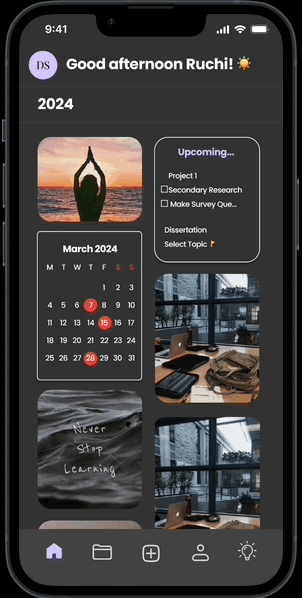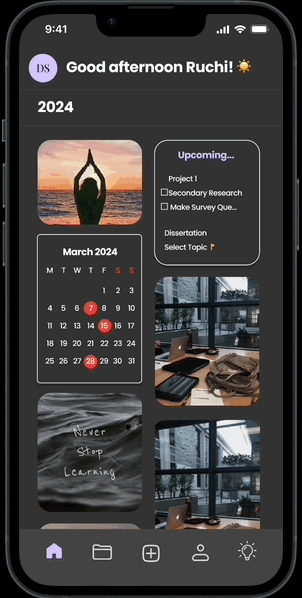DreamScape
A Stanford Design Thinking case study

_JPG.jpg)
_JPG.jpg)
.jpeg)
A few questions from user interviews
.png)
Love Letter / Break-up Letter Activity with participants
Overlooking Progress
By not acknowledging their past achievements, many individuals miss the opportunity to build momentum and motivation for achieving other goals.
The Problem
Vision Boards that just sit still and look pretty
Vision boards are exciting to create, but without a solid action plan to back those goals, they are reduced to mere sources of passive inspiration.
People often procrastinate, set rigid goals as deadlines approach and end up abandoning goals that aren't urgent due to lack of motivation and flexibility.
Rigid Goal Setting and Procrastination
About
An app designed to empower users to accomplish their goals by combining the power of visualisation, through vision boards, with the structure and clarity of the SMART goal-setting method.
Duration
2. . 5 months

Vision boards are powerful for sparking motivation, but often fall short in driving lasting action due to the lack of a structured approach to turn inspiration into action. There is a clear opportunity for a solution that transforms visualisation into a strategic roadmap of goal-setting frameworks, helping individuals successfully achieve their goals.
Market Gap
My Role
UX strategist | UX researcher | Interaction Designer | UX Analyst | Usability Specialist

Empathise
The Empathise phase consisted of gathering insights from participants and understanding their behaviours around goal setting, following a semi-structured format for the interviews
Methods used
-
Moderated User Interviews (5 participants)
-
Love Letter Break-up Letter
-
Focus Group session (3 participants)
After jotting down the insights, an affinity map was charted to highlight essential themes.
The key areas of focus include:
-
Approach to goal setting
-
Tools used for goal setting and visualisation
-
Motivation factors
-
Obstacles in goal setting
-
Dealing with setbacks
-
Expected features
.png)
Affinity Mapping

SWOT Analysis of competitors
After conducting a competitor analysis, I mapped my findings onto a SWOT chart, which helped me identify different strategies and opportunities for my design.
Define
The key deliverables of this phase include Empathy Maps, User Personas, Customer Journey Maps, POV Statements and User Stories
.png)
.png)
Two distinct user groups were identified during Empathy mapping, revealing common underlying themes
Personas that shaped the design
.png)
Some User Stories for Emily
-
As a visually driven achiever, I want to seamlessly integrate my vision boards so that I have a unified view of my long-term and short-term goals.
-
As a graduate student with a structured way of working, I want to break down my goals from the vision board into actionable tasks that I can track along the way.
-
As a reflective goal-setter, I want the ability to update and reflect on my goals easily.

.png)
.png)
Some User Stories for Louis
-
As an individual who thrives under pressure, I want an app that automates mundane tasks so that I can focus on immediate goals and optimise my productivity.
-
As an efficient multi-tasker, I want to receive context-aware suggestions for task batching so that I can maximise my productivity by breaking goals into smaller, manageable tasks.
-
As a busy part-time student, I want to integrate my personal, academic and professional calendars in a single app so that I can have a holistic view of all my commitments.
.png)
.png)
.png)
.png)
Ideate
To freely explore ideas and arrive at potential solutions I used the following methods How might We Statements, Rapid Idea Generation, Worst Idea Possible .


-
To tackle user pain points and needs, I formulated five HMW statements for each persona based on the POV statements and User Stories defined in the previous step.
-
The Rapid Idea Generation Technique helped generate some interesting ideas. While some ideas seemed feasible, others were overly ambitious and more challenging to implement.
-
By deliberately thinking about the most counterproductive features for my app, the Worst Idea Possible Technique helped flip those concepts around and come up with effective solutions.
Ideation methods used

-
The various ideation techniques helped generate a feature list, which, after iteration, was evaluated using the NUF test.
-
I set the threshold score to 20 -
Features scoring over 20 were considered strong candidates for the app.
Those slightly below were revisited to explore ways to improve usability or develop a more feasible version that effectively tackles user pain points.

NUF Evaluation
Prototype and Test
The prototype phase began with sketching paper wireframes, which were fed into MarvelPop and subjected to some basic testing. I designed the Lo-Fi wireframe on Figma, and, based on user feedback, kept iterating it to create the Mid-Fi and Hi-Fi versions. I then ran Concept Testing sessions to gauge user responses to the app.




































Switch to a desktop browser for the full experience
1
Tie your vision board to SMART goals for a structured approach to realising your goals.
Turn your Vision Board elements into actionable goals
The Solution
These are the proposed solutions to the problems identified in the initial phases of this project


SMART goal setting
-
Instead of tying yourself down to rigid goals and endless to-do lists, focus on clearly defining your goals, so that they are Specific, Measurable, Actionable, Reliable and Time-bound.
-
75% of participants were aware of the SMART goal setting concept, yet only 12 . 5% had actively implemented this strategy individually.
-
Additionally, 25% of the participants mentioned encountering SMART goal-setting strategies in their workplaces, where they achieved 95% of their set goals every time they resorted to this method, indicating its effectiveness.
2
The Accomplishment board
Watch your vision shape into victory
-
An engaging approach aimed at boosting motivation and improving accountability by keeping the users hooked on their progress.
-
Designed as a dynamic twin of the vision board, however, there’s an interesting twist: all images are greyed-out placeholders. As users achieve their goals over time, they will be able to replace these initially greyed-out images with real photos of their accomplished goals.
-
This gradual transition offers a visually rewarding experience which represents their progress over time. This not only motivates users to keep crushing their goals but also reinforces a sense of accountability.
-
Once complete, the users can download their accomplishment boards, compare them with their vision boards or share their progress with their loved ones.
